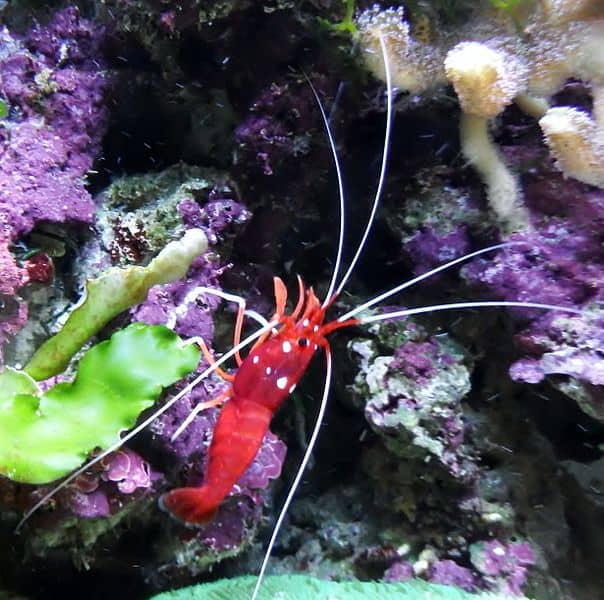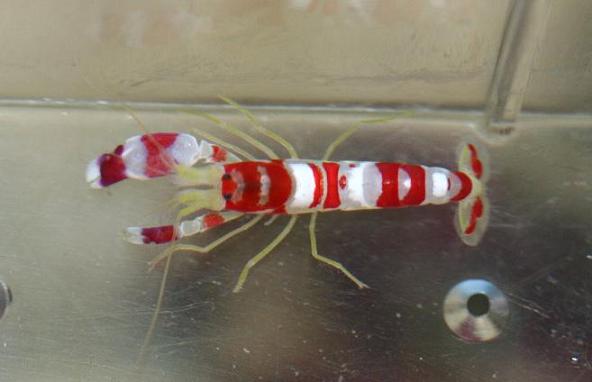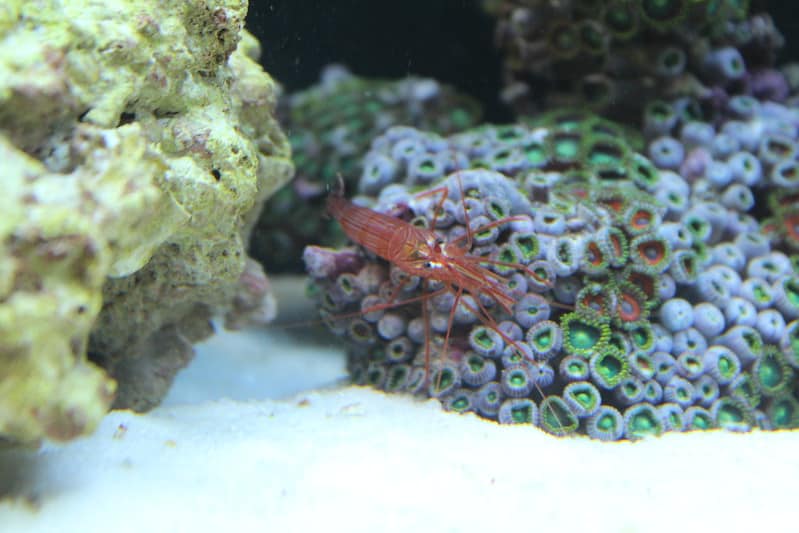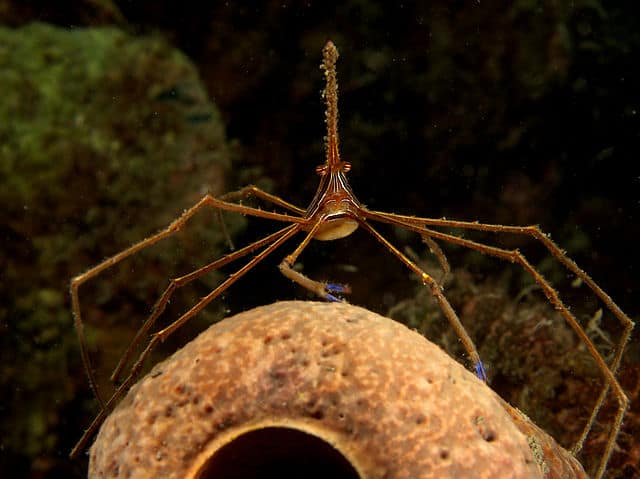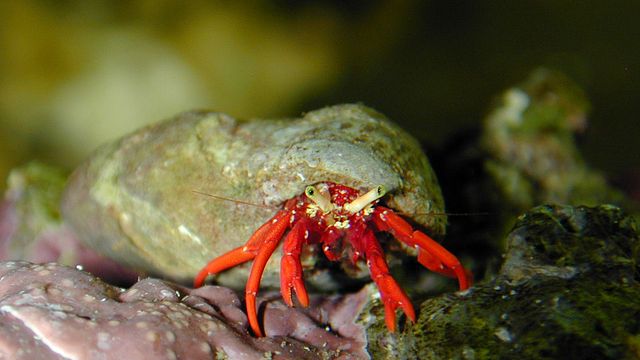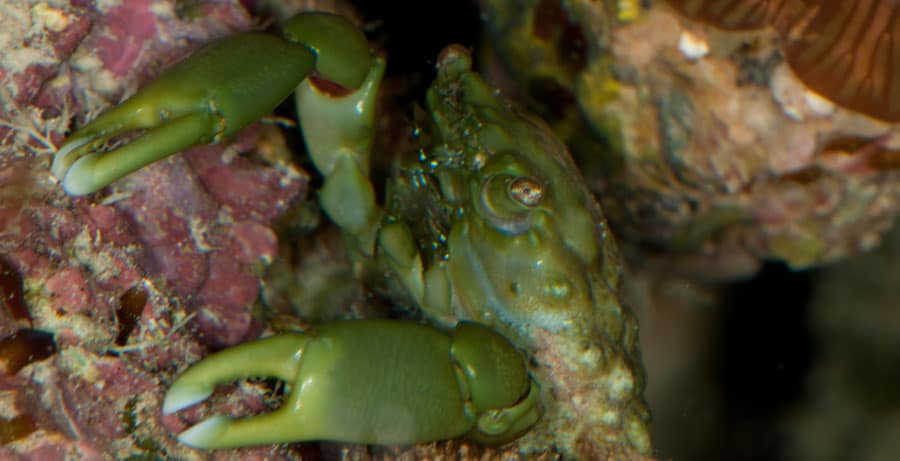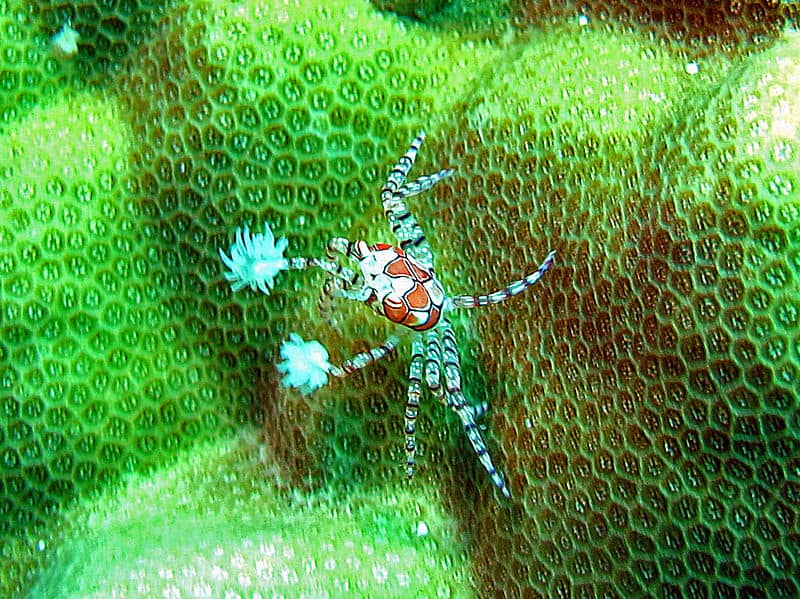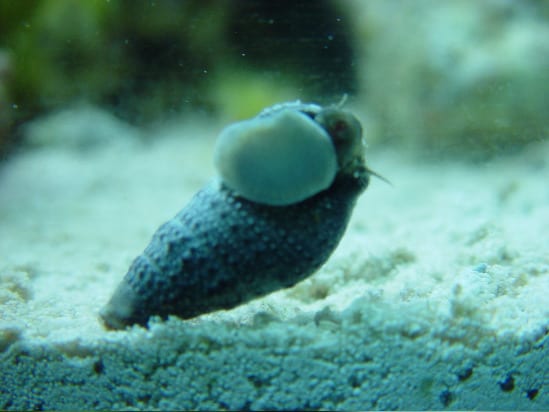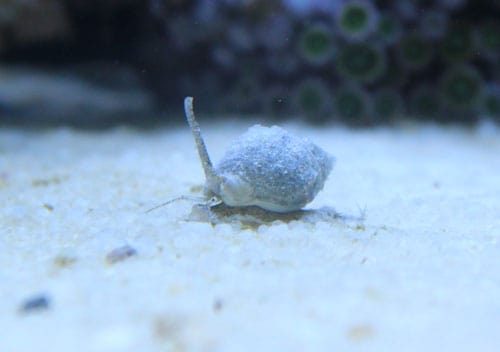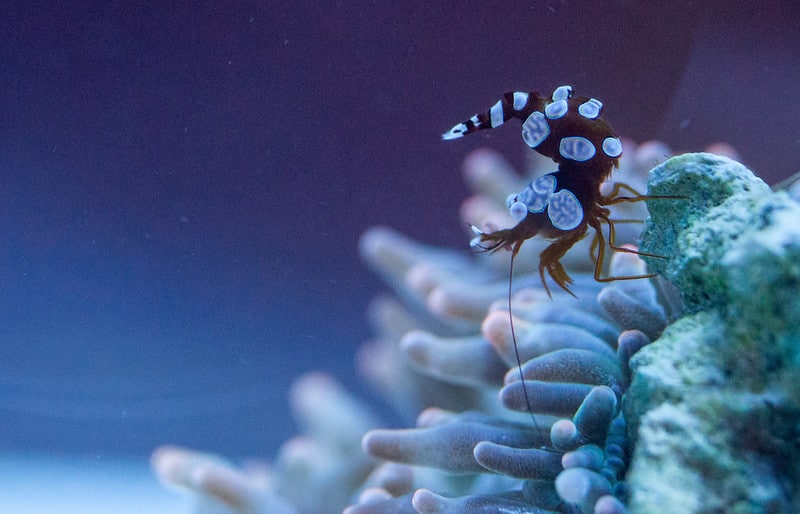Diversity in any saltwater aquarium is the key to making your aquarium not only beautiful but interesting. One of my favorite things is to watch my Hermit Crabs crawling over everything or my Cleaner Shrimp servicing another fish in his cave.
Invertebrates are some of the most unique characters you can have in your aquarium and the selection available ensures there is something for every sized aquarium.
Some of the Best Beginner Saltwater Invertebrates are:
- Cleaner Shrimp
- Hermit Crabs
- Mexican Turbo Snails
- Brittle Stars
- Sexy Shrimp
- Nassarius Snails
- Astrea Snails
- Peppermint Shrimp
- Pom Pom Crabs
- Mithrax Crabs
There are so many invertebrates to pick from but many require large, mature aquariums, fish-only aquariums or specialized feeding. This article is only going to cover the really easy invertebrates to help you begin adding diversity to your box of water.
What Are The Best Types of Saltwater Invertebrates?
Saltwater invertebrates make for some of the coolest and family favorite inhabitants in most home aquariums. My daughter loves our Cleaner Shrimp. She calls him ‘Fingers McGee’ because he is always picking away at things with his claws.
The other great attribute to many of the invertebrates you see is that they are great cleaners and you may have heard the term ‘Clean-Up-Crew’. This is a diverse team of invertebrates that you collect to help keep your aquarium clean.
Algae, detritus (fish waste and uneaten food) and dead or decaying material form the basis of what these guys will help to keep under control, all while giving you something interesting to watch!
Shrimp
Cleaner Shrimp (Lysmata amboinensis)
One of the most popular shrimp that you will ever see. These super hardy, super helpful shrimp are a great addition to any reef. They will set up a ‘Cleaning Station’ at their chosen overhang or cave to allow fish to come to them to have dead scales and parasites picked from them.
These reef-safe, peaceful animals make great additions to any tank and when bought small are great for a Nano-Reef. These shrimp will become very active when food is introduced into the aquarium. You can find them swimming and stealing food from the mouths of your coral!
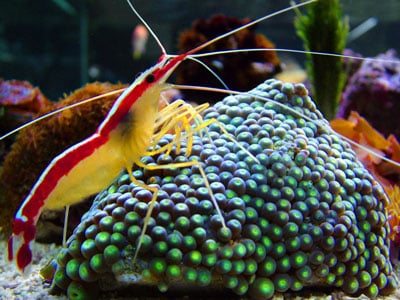
From $31.99
Find Out More Information HERE at Saltwaterfish.com
Fire Shrimp (Lysmata debelius)
Probably the second most popular saltwater shrimp you will find in an aquarium. The bright red coloration of this shrimp really draws the eye when they are our cruising your tank, but that vividness will cost you more!
Another cleaning shrimp but does not seem to be as bold as the Cleaner Shrimp. This shrimp is another inhabitant you can add to a nano aquarium when purchased small.
They like to hide in dark areas so ensure that you provide plenty of rock for them to find a place to call home.
From $48.99
Find Out More Information HERE at Saltwaterfish.com
Pistol Shrimp (Alpheus randalli)
The Pistol Shrimp is one of the only shrimp available in our hobby that has natural symbiotic relationships with Gobies.
Pairing a Pistol Shrimp with a Yellow Watchman Goby will give your aquarium a unique but odd couple. They will share their own sand cave, with the shrimp providing protection while the Goby provides the early warning.
Ensure you have a sandy substrate and lots of live rock for this shrimp to make its cave.
From $25.99
Find Out More Information HERE at Saltwaterfish.com
Peppermint Shrimp (Lysmata wurdemanni)
The Peppermint Shrimp is one of the first lines of defense against the dreaded Aiptasia coral pest. This shrimp will actively seek out this nuisance intruder and devour every one it finds.
Many aquarists have one of these in their tank as a preventative solution incase any Aiptasia make it through your acclimation inspections of new coral, or hiding in unseen areas of live rock.
These shrimp look very similar to Camelback shrimp which do not prey on Aiptasia.
From $9.99
Find Out More Information HERE at Saltwaterfish.com
Crabs
Arrowhead Crab (Stenorhynchus seticornis)
A very unique longlegged crab that will instantly bring attention to the viewers of your aquarium.
This crab is a fast mover due to its long legs and should only be kept in larger aquariums with fast-moving inhabitants. They are easy to keep be do not keep them with Feather Dusters or Coral Banded Shrimp as they will become its next meal.
This crab will eat anything it can get its claws on and will steal food from the mouths of coral and any other inhabitant it decides.
From $23.99
Find Out More Information HERE at Saltwaterfish.com
Scarlett Hermit Crab (Paguristes cadenati)
Hermit crabs are one of my favorite invertebrates in my aquarium. Their unique homes carried on their backs make them an interesting character. I recommend the Scarlett Hermit crab for beginners as hermit crabs can demolish your snail population for their shells.
The scarlet is a rather placid crab and tends to leave the snails alone, making them a better option for you. Just purchase a variety of different sized empty shells from the fish store and drop them out of sight behind the rocks for them to find.
These scavengers will eat anything they find including algae.
From $6.99
Find Out More Information HERE at Saltwaterfish.com
Emerald Crab (Mithrax sculptus)
Also commonly known as the Mithrax crab these Little Green Algae-Munching machines are perfect for helping prevent the spread of Bubble Algae. Just like the Peppermint Shrimp, they can be kept in your aquarium to help them seek out and destroy Bubble Algae before it has the chance to bloom.
They will eat any other algae they find but keep them fed with nori if your aquarium is unmatured or clean. The females tend to be less aggressive to other tank mates and prey on the algae more.
From $7.99
Find Out More Information HERE at Saltwaterfish.com
Pom Pom Crab (Lybia tessellata)
Also commonly known as the Boxing Crab due to the appearance of boxing gloves on its claws. These anemones are used to collect minute food particles passing through the water on which it feeds.
It can also be seen waving its pom pom’s at nearby inhabitants that it wants to warn off. This is a tiny crab growing up to about 1″ in diameter and as such needs to be kept in a peaceful aquarium to prevent it from becoming a meal.
The size of this crab and its ease to keep make it perfect for nano aquariums.
From 23.99
Find Out More Information HERE at Saltwaterfish.com
Snails
Cerith Snails (Cerithium sp.)
The long slender shell make this an instantly recognizable member of your janitorial army.
These nocturnal algae eaters bury themselves in the sandbed during the day which helps to keep detritus build-up at bay while turning over the sand at the same time.
They are super easy to keep, requiring no additional attention from you. Don’t be worried if you never seem to see them as they will be buried. Inspect your aquarium at night with a flashlight and you will see them out doing their job.
From 3.49
Find Out More Information HERE at Saltwaterfish.com
Nassarius Snails (Nassarius sp.)
My all-time favorite snail! I always have an army of these workaholics!
Another snail that buries itself in the sand bed and helps keep it turned over, but you can find these guys because their ‘Snorkel’ sits poking out of the sand waiting to sniff out food!
These snails will cruise the sand, glass, rocks and eat everything, but their best feature is they can right themselves if they get knocked off the glass.
Many other snails are unable to right themselves becoming an easy meal for fish and crabs.
From 1.99
Find Out More Information HERE at Saltwaterfish.com
Mexican Turbo Snails (Turbo fluctuosus)
The Bulldozer’s of the aquarium Clean-Up-Crew! These algae-munching monsters never stop. You can usually find them on your glass leaving funky trails wherever they have been.
These are snails best introduced when a tank is mature enough to have a consistent supply of algae or when you begin to see the signs of on algae bloom starting.
Their large size gives them the Bulldozer nicknames as they will nock off small rock and corals if they are not secured well.
These snails are unable to right themselves so you may find you are regularly giving them a flip over before the hermits find them!
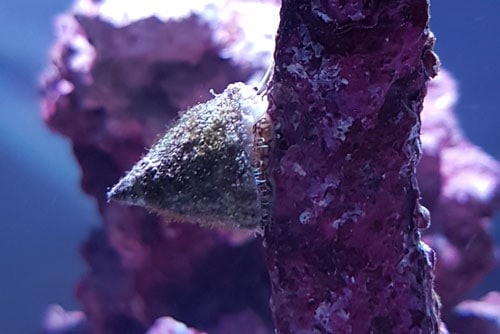
From 3.49
Find Out More Information HERE at Saltwaterfish.com
Bumble Bee Snails (Engina sp.)
The Black and Yellow stripes on its shell give them the aptly named Bumble Bee. The omnivores will cruise the aquarium feeding on both algae and detritus.
Similar to the Nassarius snail, they have a snorkel on the front of their head that allows them to reach into cracks and crevices to remove food, but also to right themselves if knocked over.
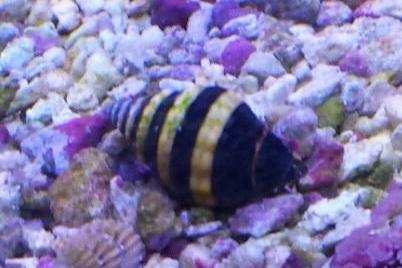
From 4.99
Find Out More Information HERE at Saltwaterfish.com
What Are The Best Invertebrates For A Nano Reef Aquarium?
Many of the invertebrates above can work great in a nano tank but the main thing you want to consider is how much room is that animal going to take up in your aquarium.
If you have a small 13 Gallon Fluval Sea, for instance, the room a Coral Banded Shrimp will take up is a lot. He may be the only larger animal you can have in there, and by doing so it could become aggressive and prey on your other livestock.
It is always best to match the animal’s adult size to your aquarium. Nerite and Cerith snails are good for smaller tanks, a Pistol Shrimp/Yellow Watchman Goby would make a great focal point or one of my personal favorites, the Sexy Shrimp!
These tiny shrimp reach about 1″ in length when fully grown and have a very animated ‘Butt Wobble’. Kept with peaceful tankmates these shrimp will thrive and if allowed will form a symbiotic relationship with Anemones. When paired with Maxi-Mini Anemones these shrimp will add some great movement to a beautifully colored Maxi-Mini.
From 25.99
Find Out More Information HERE at Saltwaterfish.com
Here are some stocking examples for a nano tank:-
Pistol/Goby Pair
2x Sexy Shrimp
2x Scarlet Hermit Crabs
2x Nassarius Snails
2x Bumble Bee Snails
or
Cleaner Shrimp
Pomp Pom Crab
2x Scarlet Hermit Crab
2x Cerith Snails
2x Astrea Snails
When picking your invertebrates, try and pick animals they prey on different food groups as this will give you a more efficient janitorial team. Keep them small and peaceful and you will have a nice piece of the ocean in your room.
When Can You Add Invertebrates To A Saltwater Tank?
Although the majority of invertebrates are fairly cheap they should not be treated as ‘Cannon-Fodder’ to see if your water is cycled and not toxic any more! Just like fish, the invertebrates need to have your aquarium fully cycled before they are introduced.
The best way to add invertebrates to your aquarium is bit-by-bit as their food sources begin to appear. By adding Turbo Snails to a tank without a spec of algae in it is just going to ensure they starve to death.
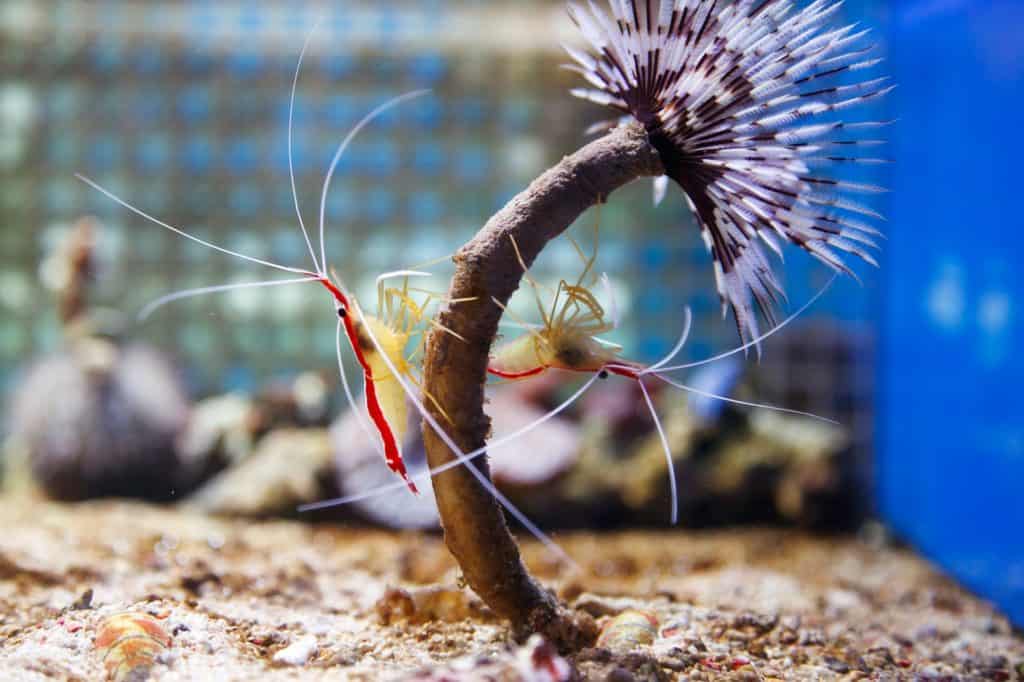
Adding Nassarius snails to a brand new sandbed will have no detritus build-up for them to scavenge on. As your food source grows, add the invertebrate you wish, that preys on that food.
Stay away from the larger ‘Invert Packs’ you can find at many retailers. Most of these animals will perish once the food source is quickly consumed. As these animals perish they decay and release the nitrates and phosphates they consumed back into the water but now with the added bonus of their body now adding to the situation.
Just add the animals you wish, a few at a time and monitor how they go. If you need more, buy a few more next time you are in the store.
Invertebrates are very sensitive to rapid water parameter changes. Be sure to slowly drip acclimate them over at least a 2 hour period to ensure they begin life in your home as healthy as they can.
To Finish
There are many, many invertebrates in our hobby to chose from but to begin with I recommend you stay with ones listed above. These are generally very placid, easy-to-keep inhabitants that will ensure you have good success with them.
Adding invertebrates that your aquarium is not ready for, is not big enough for or have specific dietary or habitat needs is a sure-fire way to have them die and you waste your money.
Some invertebrates like Nudibranches can even release toxins into the water when they die leading to a tank crash. I have seen it many times and it is a terribly sad consequence.
Beginning with the easy stuff gives you the most enjoyment while stretching that dollar further. I hope this article has helped!
Further Reading
Here are a selection of my other articles you might be interested in:

